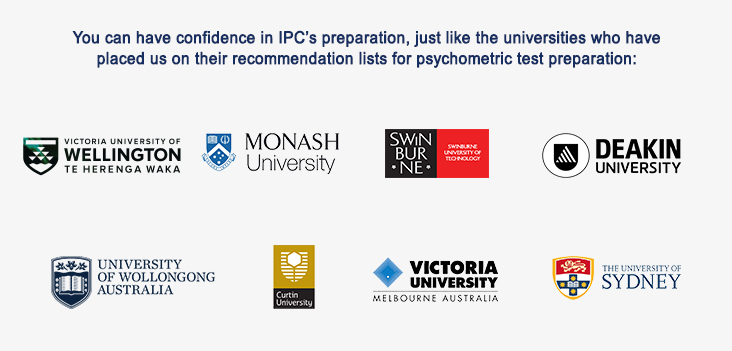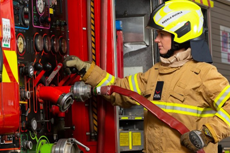Preparing for Fire Rescue Victoria (FRV) Written Selection Test (WST), Group Assessment and Personality tests - timed practice WST tests with real questions, detailed answer explanations, online courses & 1-on-1 personal tutoring 2025
Pass your Fire Rescue Victoria (FRV) tests (updated version 2025)
- FRV self-managed preparations from $89
- 1-on-1 coaching by experienced psychometricians from $237
- Preparing applicants fsince 2007.
If you are applying to join Fire Rescue Victoria (FRV), you will be required to undergo several challenging Psychometric tests with Pearson’s Vue:
1. In your initial screening you will be asked to complete a Written Selection Test (WST) by Pearson VUE which includes several timed cognitive tests:
- Abstract reasoning test.
- Verbal reasoning test.
- Numerical calculations test.
- Mechanical comprehension test.
2. Then, you will be asked to participate in a group assessment, which would measure how well you work with others.
3. Then, you will be asked to complete a Clinical personality test to ensure no personality issues that might hinder your performance as a firefighter.
What to expect in your verbal reasoning test in FRV's Written Selection Test (WST) Pearson VUE:
The Verbal reasoning test questions in WST Pearson VUE’s verbal reasoning test are multiple-choice test questions. These questions are designed to measure your verbal reasoning skills which includes your ability to process verbal information in an effective and efficient manner, identify critical issues and master the English language as a way to communicate and comprehend instructions.
FRV tailored example verbal reasoning test questions:
FRV's verbal test is designed to measure your ability to use the English language. In your Pearson's VUE verbal test you will have a list of verbal test questions to complete in a given time. The timer is set for the entire test. The verbal test question style typically includes pairs of words that are associated in some way (i.e. an analogy) and a list of options. Your task is to select which of the options is most like the given word association.
Let’s look at a typical verbal reasoning test example:
Cane : walk, as eyeglasses ?
A. taste
B. hear
C. colour
D. run
E. observe
F. sun
The association between ‘cane’ and ‘walk’ is that the cane is an ancillary instrument to assist someone to walk. Therefore, we need to find a word in the list with a similar association to ‘eyeglasses’. ‘Eyeglasses’ are an ancillary instrument to help someone ‘observe’, so this forms the same relationship as exists between ‘cane’ and ‘walk’.
What to expect in your abstract reasoning test in FRV's Written Selction Test (WST) Pearson VUE:
The Abstract test questions in WST Pearson VUE’s test are also timed and are forced-choice (which means that each question has between 4 to 5 answer options and only one is correct). All Abstract test questions are non-verbal problems, which means that there is no text to read. Each Abstract test question displays a group of shapes that have some common patterns or rules. Your task is to quickly identify the patterns and logical rules for each group of shapes and then use them to select the correct answer. Each Abstract test question in the Cognitive test has a different group of shapes and different patterns and logical rules.
FRV tailored example abstract reasoning test question:
Let's review a second example for a 3 by 3 matrix abstract question. In this question there are 8 shapes in a 3 by 3 table. The 9th shape is missing and your task is to find what it is based on the other shapes.

To solve this question, we need to find the logical rules that apply to the shapes going from left to right or top to bottom. We can see that in each cell in each row contains a black rectangle or box. The last cell in each row is a combination of the first two boxes of the first and second cells. So, if we look at our top row, the first two black boxes in first and middle cells are combined in the last cell to create a vertical black rectangle. Therefore, the missing shape is a full black box which is a combination of the two horizontal black rectangles.

What to expect in your numerical calculation test in FRV's Written Selection Test (WST) Pearson VUE:
In your Pearson's VUE type numerical test you will be asked to demonstrate the capability to add, subtract, divide and multiply two numbers with two digits each. You will also be asked to use algebra to group variables. The variables can be a simple variable such as X or Y and it can also be X squared or Y squared.
FRV example numerical calculation test questions:
In the following question you are asked to sort or group items (variables). Your task is to find which of the answer options is identical to the equation in the question
5 (X – 4) + 3X = ?
a. 2X – 4
b. 8X – 4
c. 20 + 3X
d. 8X - 20
e. 20X -4
f. None of the answers
In this question you are asked to group all similar items (variables and free numbers) and this requires you to cancel out the brackets. There are two groups here – one is all the items with the variable X and the other is all free numbers. First thing is to cancel the brackets by solving them, then group the items. The rule when you cancel brackets is that you times the number before the brackets with each number within the brackets. As 5 is the number before the brackets then to cancel the brackets we need to do 5 times X, plus 5 times -4. Then we are left with 5X + 5 x -4 + 3X = 5X – 20 + 3X. All the items with the variable X are 5X + 3X = 8X. All the free numbers are -20. Therefore, the correct result is 8X - 20.
Let's now review a different type of numerical claculation test question:
9x + 6 : 2 x 5 - 3 + x = ?
Answer Options:
10x + 12
9x + 12
9x + 14
10x + 15
This question measures your ability to understand and apply the correct order of operations. The rules for the order of operations are fairly simple but you need to memorize them. The order of operations is: first, we do the numbers in parentheses/brackets. Then, we do exponents (a number in the power of something). Then, we do multiplications and divisions based on the order they appear (from left to right). Lastly, we do addition and subtraction in the order they appear (from left to right).
Let’s now apply the rules. There are no parentheses/brackets or exponents/orders so we’ll jump straight to multiplication and division. In mathematics, the colon symbol means division. Going from left to right, 6 divided by 2 is the first item we need to address. The answer is 3, so let’s replace that into the expression to get 9x + 3 x 5 - 3 + x. Next, we address the multiplication, 3 times 5, which equals 15. Replacing that into the expression gives us 9x + 15 – 3 + x. Now, we perform the addition and subtraction from left to right. 9x + x equals 10x. Then 15 – 3 equals 12. The simplified equation is 10x + 12.
What to expect in your mechanical test in FRV's Written Selection Test (WST) Pearson VUE:
FRV's mechanical comprehension test includes a set of mechanical problems that must be completed in a predefined time.Each mechanical comprehension test question offers you a mechanical scenario that can include acceleration, gravity, friction, pressure, moments, energy transformation, kinetic and potential energy, work and power, levers, pulleys, screws, gears or springs. Your task is to use mechanical principles to find the correct answer.
You should expect to have around 30 seconds to complete each mechanical comprehension test question.
Let's review the following mechanical comprehension test question example:
A man weighing 75kg is standing on bathroom scales inside a moving elevator. The scales show that he weighs 60kg.
Which way is the elevator travelling?
- the elevator is accelerating upwards
- it is impossible to tell
- the elevator is accelerating downwards
- the elevator is spinning
To answer this mechanical comprehension test question, you must consider a mechanical principle relating to gravity. When the elevator is still, the pull of gravity is equalised by the ‘upward’ push of the floor and the scales will show the normal weight. However, while the elevator is accelerating downwards, the pull of gravity is temporarily reduced (because there is less upward equalisation) and the scales will show a lighter weight. As the man's weight drops when in the elevator from 75kg to 60kg, we can conclude that the elevator is accelerating downwards.
FRV's next step assessments:
Once you completed your initial tests you will be asked to participate in a group assessment. The group assessment will include some additional tests and a group exercise. These are used to measure your personality and behaviour in a group setting.
1. FRV's Work Safety test
The Work Safety test is a non timed personality test that has just over 30 test questions. Each test question has a statement and you are asked to select the degree to which you agree with the statement about you.
The test measures risks in your work safe behaviour that might impact your ability to be a firefighter. The test measures your work safe behaviour using 5 scales:
Scale 1 – Risk Avoidance, or Risk Averse, or Cautious
Scale 2 – Safety and Personal Accountability/Responsibility
Scale 3 – Managing Stress, Emotional Resilience, or Being Strong
Scale 4 – Aggressive or Violent Behaviour
Scale 5 – Compliance and Obedience
Let's review the following example of a work safety test statement:
If a person is insulted then he is entitled to be angry
- Strongly disagree
- Disagree
- Neutral
- Agree
- Strongly agree
The statement is designed to measure your ability to manage your anger and frustration in the work place. If you were to choose “agree” to this statement, then this would indicate that you are likely to approve of aggressive behaviour in the work place, which is likely to lead to accidents.
2. FRV's personality profile test
FRV use a special clinical personality test that measures personality disorders. The test includes more than 300 items and is not timed. The test report offers FRV a full clinical personality profile of you. this report focuses on personality disorders such as anti-social behaviour, borderline personality, assertiveness and aggressive behaviour.
Each test question includes a statement and you are asked to state to what extent this statement is you on a 4-points scale (from strongly disagree to strongly agree). Each question only measures one scale but there are several questions measuring the same scale. All questions are measuring the scales in a covert manner. This means that you will not know what the question measures. Here, is the risk. Many people wrongly assume that what each test question measures. They assume that a question measures one personality scale while, in reality, it measures another scale. Then, they answer the questions in the wrong way.
Example personality test question:
I have a lot of brilliant ideas.
- Strongly disagree
- Disagree
- Neutral
- Agree
- Strongly agree
While this question may seem very simple to answer, it measures a manic-depressive personality disorder, If you answer strongly agree then this is one indicator that you have a manic personality disorder.
How we prepare you for FRV's Written Selection Test (WST), Personality profile and Group Assessment:
The Institute of Psychometric Coaching has developed a variety of tailored preparations to ensure you are ready for your tests with Fire and Rescue Victoria..
Our professional preparations include:
FRV tailored practice tests - FRV's Written Selection Test (WST) Pearson VUE - Abstract reasoning, Verbal reasoning, Numerical calculations & Mechanical comprehension tests:
- A large pool of reasoning timed practice FRV tailored with real timers - Abstract Reasoning, Verbal Reasoning, Numerical Calculations & Mechanical Comprehension tests.
- Based on real WST Pearson VUE's test questions.
- Step by step answer explanations at the end of each test.
- Test scores in comparison to others.
- Timers are used to mimic test pressure.
- Guidance about how to improve.
- Immediate access.
Practice FRV's clinical personality tests
- A full scale practice personality test..
- Based on FRV's personality test
- Test scores in comparison to others.
- Guidance on how to improve.
- Immediate Access.
Online FRV courses for Written Selection Test (WST) Pearson VUE - Abstract reasoning, Verbal reasoning, Numerical calculations & Mechanical comprehension tests:
- Mechanical reasoning tests courses online with all the knowledge you need to pass Fire Rescue Victoria tests.
- Abstract Reasoning Test Course online with some example test questions.
- Verbal Reasoning Test Course online with some example test questions.
- Numerical Sequences Test Course with some example test questions.
- Immediate Access.
1-on-1 personal tutoring for FRV's Written Selection Test (WST), Personality profile and Group Assessment:
- Delivered by Australian psychometricians who are experienced with WTS Pearson VUE's tests.
- Face to face or via Teams live or in our Caulfield north office..
- Includes an analysis of your weaknesses.
- Working with you to ensure you know how to demonstrate your capabilities in all FRV test questions.







